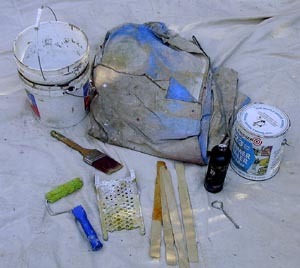But just because it's on the shelves doesn't mean that it's good. It's tough to beat the tried and true painting tools, the brush and the roller. The first is perfect for clean edges and cutting in around wall transitions, the second is unbeatable at quickly covering large, flat areas. So, curious as to what the sprayer has to offer against these two aces of acrylic, we tested a new model head-to-head against the old standbys to see how it would measure up. The whole time I kept asking myself, "What do paint sprayers bring to the table?"
For these tests, I used an angled 2-1/2-inch Purdy brush, a White Dove roller with a O-inch pile, and the Wagner Power Painter Plus Sprayer.
Test No. 1: Casing
For this test, I nailed a 4-foot 2 x 4 to a piece of 3/4-inch pine to simulate a vertical seam requiring paint to be finessed along a raised edge. When painting around a window casing, this is a standard procedure for the paintbrush. Using the traditional tool, it took me 2 minutes 44 seconds to cut in a clean line against the 2 x 4. The sprayer, on the other hand, required a good deal of protection in order to keep the paint spray off the 2 x 4. Taping the plastic took 2:05, but once I got to spraying, it only took an additional 8 seconds, giving the sprayer a total of 2:13, more than 30 seconds faster than the brush. I also noticed that since the sprayer lays down a thick coat of paint, the result after just one spray was equivalent to two coats of brushed-on paint. Additionally, the sprayer had no problem filling in all the nooks and crannies in pine knots, an area where the brush struggled.
Test No. 2: Plywood
I timed the sprayer against a roller when painting both sides of a 3-foot x 16-inch piece of plywood. The roller dispatched the task in a quick 1:50, and I was pleased with the results. The sprayer finished the job in a very quick 1:06, but at about the 55-second mark, I started running low on paint, and the sprayer began spitting small globs on the plywood. The sputtering was not only unfortunate for the quality of the coating, it was surprising as well. Before the two tests, I had filled the sprayer tank about half-full. I thought that quantity would be plenty for completing at least the first two tests. Not so.
Test No. 3: Lattice
For the third and final test, I cut three pieces of 32-inch x 2-foot lattice and painted both sides of each section with each of the three tools. The timed results were as follows: the sprayer at 1:20, the roller at 3:15, and the paintbrush at 11:50.
Here, the sprayer was the fastest, but the amount of paint wasted was tremendous. Think about it: To the sprayer, it might as well be painting a solid surface, and the voids in the lattice got a thick coat of paint as well. In the end, I used so much painter's plastic that my garage looked like the house in E.T. when the Feds came. The brush was just tedious, finishing all of the edges took far too long. This left the roller as the big winner. While it took more time than the sprayer, it was efficient with the paint, it easily got to all of the edges, and it didn't leave me with a mess of over spray to clean up.
Test No. 4: Cleanup
I didn't time the cleanup, but consider this: I rinsed out the brush with a garden hose; the roller and the roller tray insert I just threw out; and for the sprayer, I had to dismantle the tool and meticulously clean eleven different parts, some as small as an apple stem.
Conclusions
In my tests, I discovered two important things about paint sprayers. First, they go through paint like it's an unlimited resource. Second, they're fast. While a lot of that speed is lost in the prep and cleanup process, there's no question that, once it gets going, the sprayer is the Audi to the brush and roller's Ford Tempo. But there were some functional issues. Running out of paint while spraying covered the surface with uneven globs. Because focusing the spray isn't an option, painting things like lattice is particularly wasteful.
As long as you're into taping sheets of plastic on the walls and you've got a bottomless budget for paint, a sprayer is worth considering. It has its strong points, but it's not a truly practical replacement for the old brush and roller.

